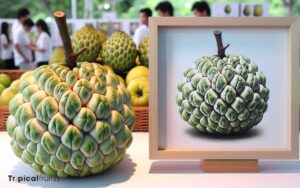How to Preserve Custard Apple? 8 Easy Steps!
To preserve custard apples, select ripe fruit, then wash, peel, and de-seed them. The pulp can be mashed and mixed with a squeeze of lemon juice to prevent oxidation.
Store the puree in an airtight container and refrigerate for up to 5 days, or freeze it for longer storage.
For whole fruit, wrap each custard apple in newspaper and store in the refrigerator crisper drawer to extend freshness.
Preserving custard apple, also known as cherimoya, requires careful handling due to its delicate nature:
A custard apple can be preserved by blending the pulp with lemon juice and storing it in ice cube trays in the freezer to create individual portion sizes.
Properly preserved custard apple can provide a delectable and tropical flavor to desserts and smoothies, making it a convenient treat that can be enjoyed year-round.
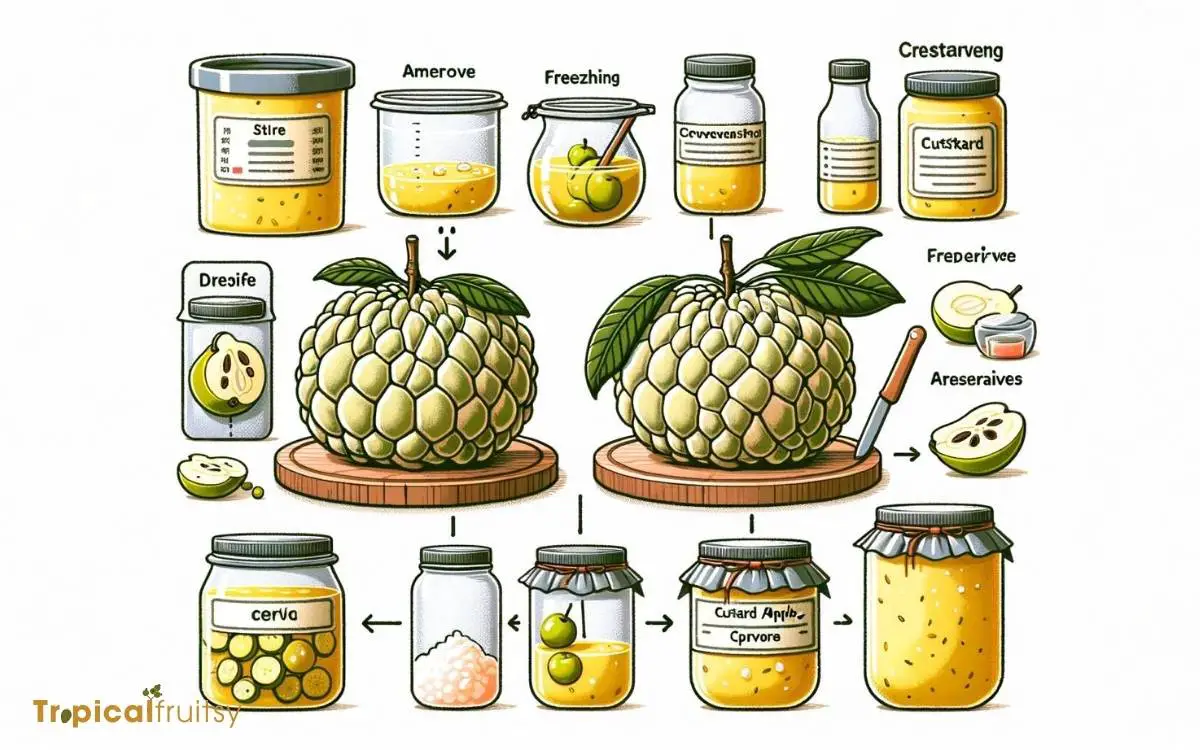
Key Takeaway
Step 1: Selecting the Right Fruit
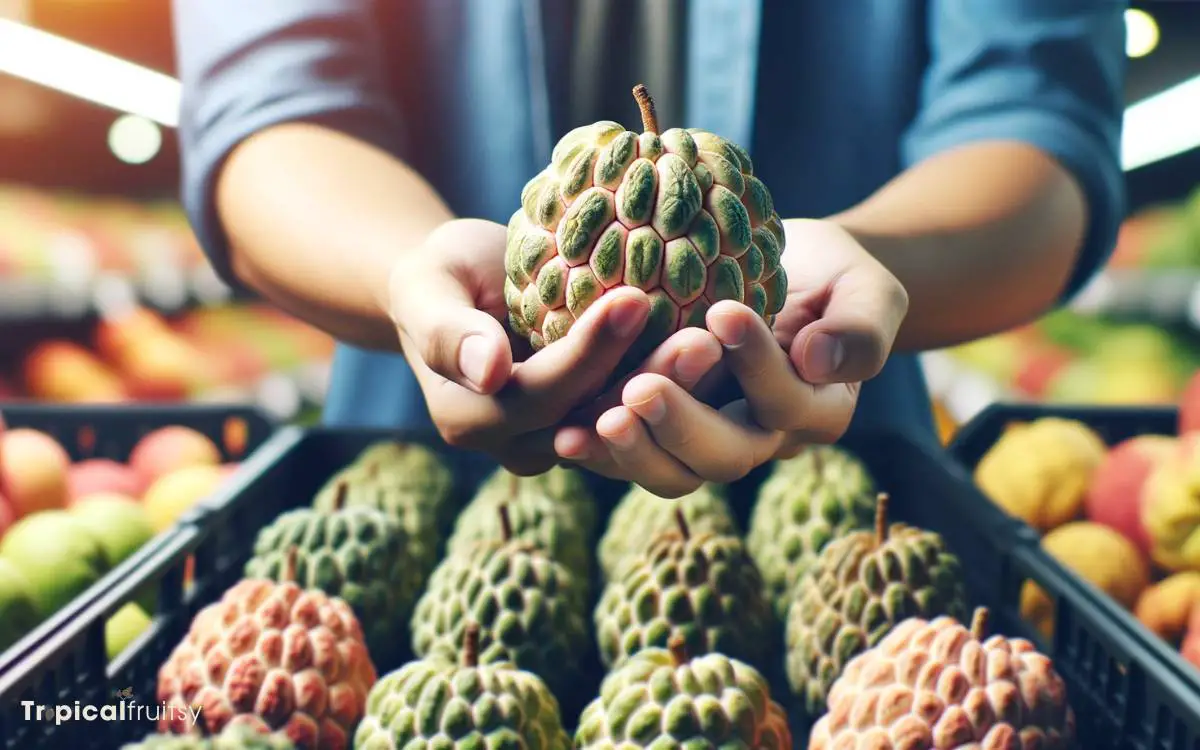
I’ll ensure the longevity of my custard apples by first choosing three ripe, blemish-free fruits with a pleasant aroma. This initial selection is crucial; a fruit that’s either overripe or underripe won’t preserve well.
To determine ripeness, I’ll apply gentle pressure to the skin, expecting a slight give. The absence of cuts and bruises is essential to prevent premature spoilage, and a sweet scent indicates a desirable internal quality.
Moreover, I’ll weigh the fruits, opting for those that feel heavy for their size, signifying a higher moisture content and robust flesh.
A systematic inspection for uniformity in color and texture further guarantees that I’ve selected the best candidates for preservation.
Step 2: Proper Washing Techniques
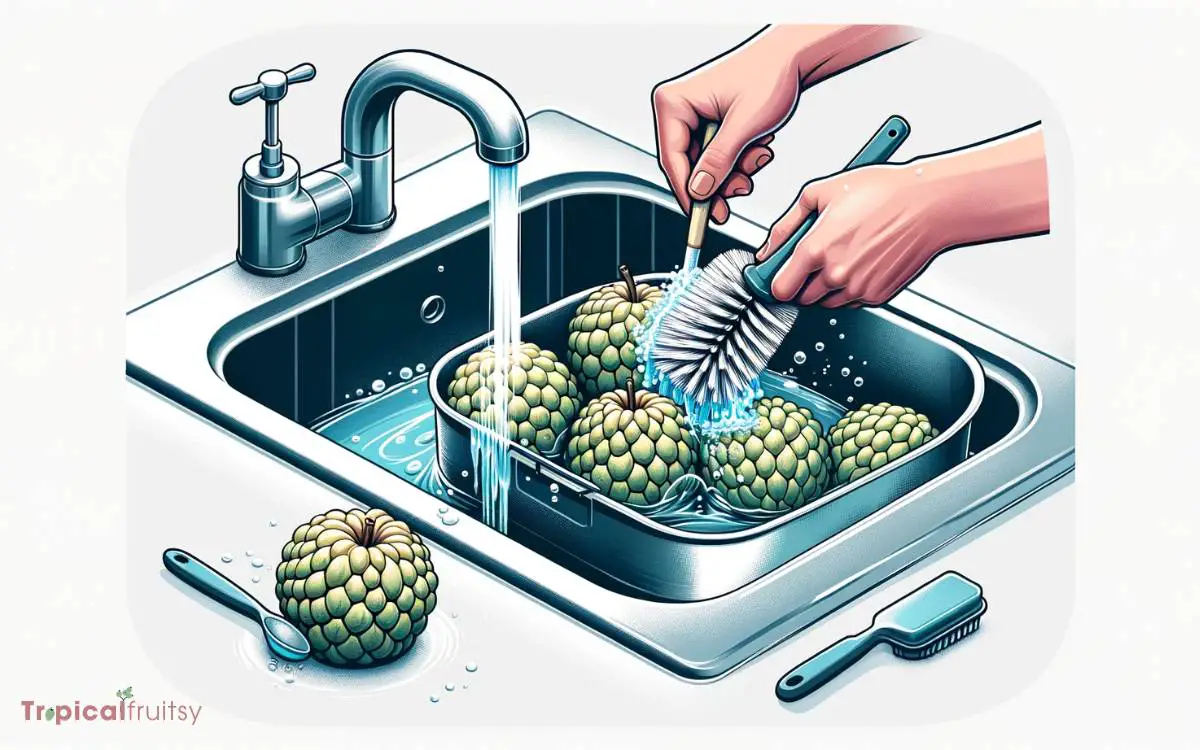
Before storing my custard apples, I’ll carefully wash each one using a mild, food-safe detergent to eliminate any surface contaminants. This process is critical to ensure the longevity and safety of the fruit.
Here’s my methodical approach:
- I’ll rinse each apple under cold running water to remove loose debris.
- Gently scrub the surface with a soft brush designed for produce.
- Apply a small amount of mild detergent and carefully wash the fruit.
- Thoroughly rinse off all soap residues to prevent any taste alteration.
- Pat the custard apples dry with a clean cloth or paper towel.
This precise and careful washing technique prepares the custard apples for safe consumption and storage.
Step 3: Immediate Refrigeration
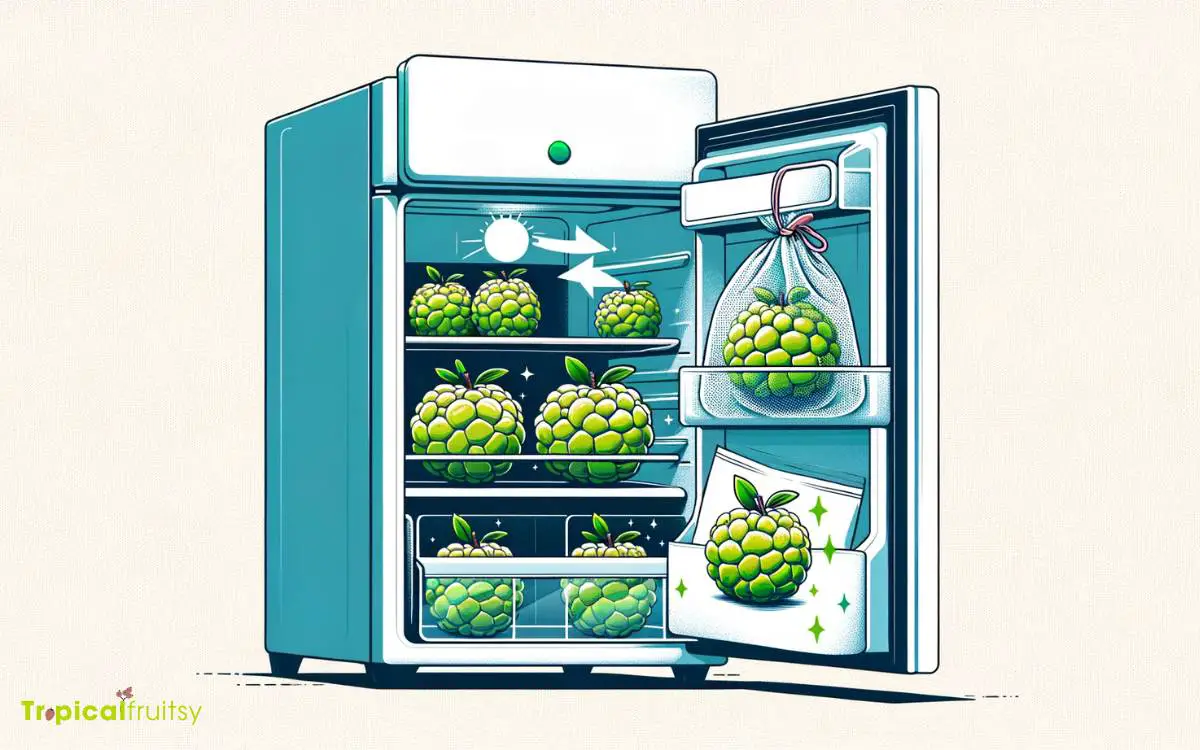
Why should I refrigerate custard apples immediately after washing?
Refrigeration plays a crucial role in halting the ripening process, which is accelerated once I wash them due to increased moisture levels. If I don’t refrigerate them promptly, the damp surface can encourage bacterial growth and spoilage.
By analyzing the fruit’s perishability, it’s evident that cold temperatures slow down the degradation enzymes, extending the custard apple’s shelf life.
Methodically speaking, I must place the custard apples in the fridge within two hours post-washing. This practice is precise in its intent to maintain quality and prevent foodborne illnesses.
For those desiring to understand the technical reasoning, refrigeration at temperatures between 35°F to 40°F creates an environment that’s less hospitable for microbial proliferation, thus preserving the fruit’s integrity.
Step 4: Freezing for Longevity
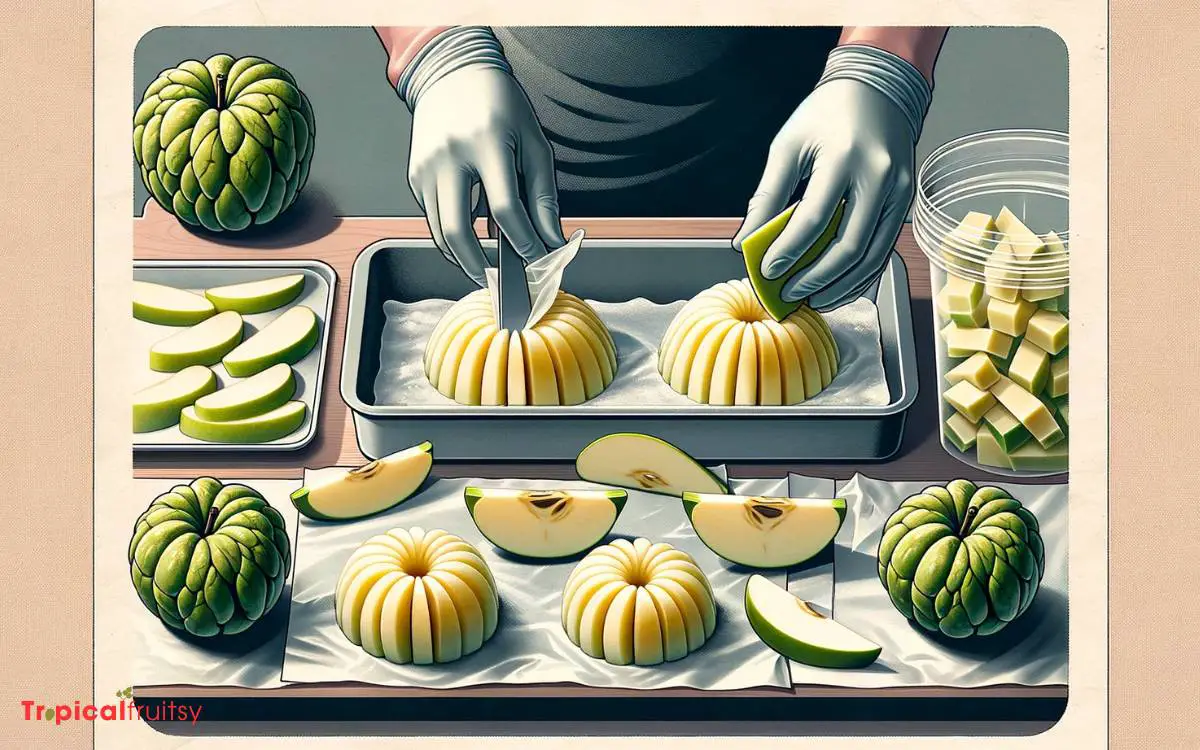
To maximize the custard apple’s shelf life, I can freeze the fruit, which effectively preserves its quality for several months. The process should be approached with a systematic methodology to ensure the best results.
Here’s a precise guide:
- Select ripe fruit: Custard apples should be ripe but not overripe, as this affects texture after thawing.
- Prepare properly: Wash, peel, and deseed the fruit before freezing to save time later.
- Portion sizes: Cut the fruit into manageable pieces for easier defrosting and use.
- Airtight packaging: Use freezer bags or containers to prevent freezer burn and odor absorption.
- Label clearly: Mark the date of freezing on the package to keep track of how long the fruit has been stored.
Step 5: Using Sugar Syrup
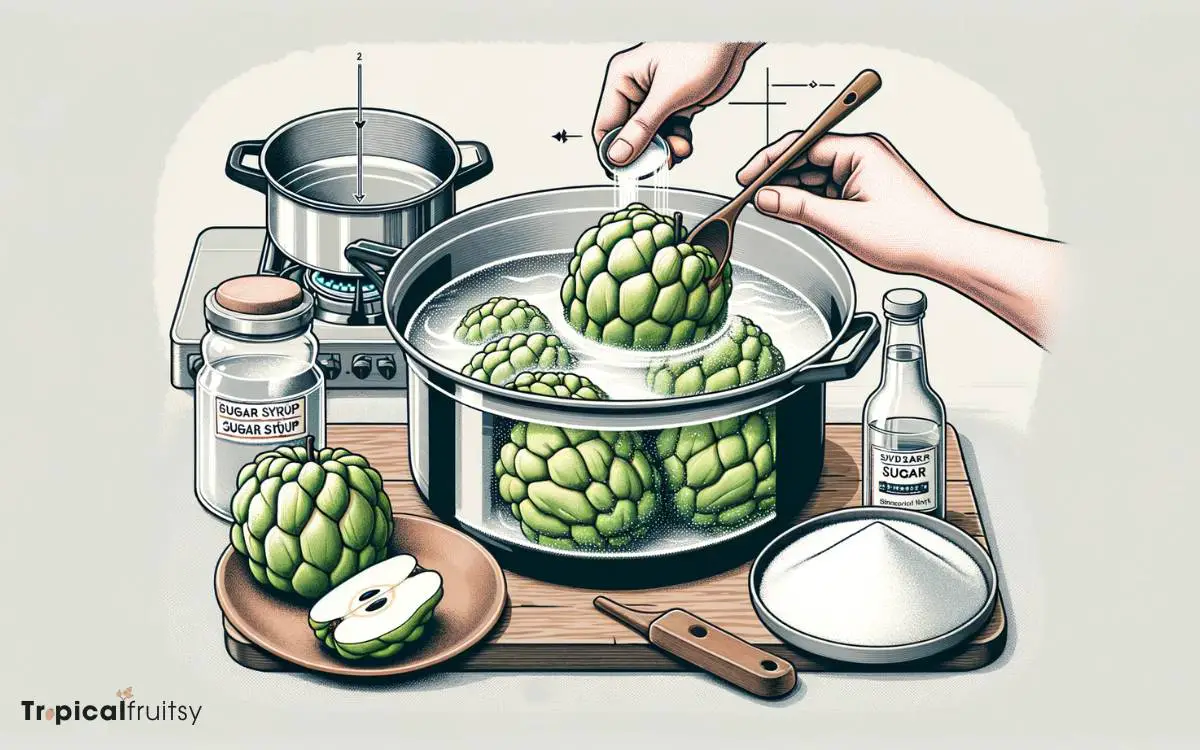
Moving on to the use of sugar syrup, I’ll analyze the critical balance of sugar to water ratios that can affect the preservation quality of custard apples.
I’ll then determine the optimal duration for immersing the fruit to ensure it retains its flavor and texture without becoming overly saturated.
This methodical approach will help us understand how sugar syrup can effectively extend the shelf life of custard apples.
Sugar Syrup Ratios
I’ll preserve my custard apples by immersing them in a sugar syrup with a ratio of one part sugar to two parts water for optimal balance between sweetness and texture. This ratio is critical in maintaining the fruit’s delicate flavor while ensuring its preservation.
An analytical approach to the sugar syrup preparation involves:
- Measuring Precisely: Ensuring the sugar and water are measured accurately to maintain the ratio.
- Boiling Point: Heating the mixture just enough to dissolve the sugar completely.
- Cooling Time: Allowing the syrup to cool before adding the custard apples.
- Submersion: Fully immersing the fruit to prevent exposure to air.
- Storage Conditions: Keeping the syrup-immersed apples in a cool, dark place to prolong preservation.
Immersion Time Limits
In preserving custard apples in sugar syrup, it’s crucial that I limit their immersion to a maximum of two weeks to maintain their quality and prevent over-softening. Extending beyond this timeframe risks compromising the fruit’s texture and flavor profile.
My analysis of the preservation process indicates that the sugar solution begins to penetrate the fruit’s cellular structure over time, leading to a breakdown of its natural firmness.
To ensure a precise and methodical approach, I consistently monitor the firmness and taste of the custard apples. If I detect any signs of deterioration, I promptly remove them from the syrup.
This disciplined approach guarantees that each custard apple retains its intended culinary characteristics, offering an optimal balance between preservation and the enjoyment of the fruit’s natural essence.
Step 6: Dehydrating Custard Apples

While dehydrating custard apples isn’t as common as other methods, I’ve found it to be an effective way to preserve their unique flavor for longer periods. The process involves removing moisture content, which inhibits the growth of bacteria and mold.
Here’s a precise guide:
- Wash the fruit thoroughly to remove any dirt or impurities.
- Slice the custard apples into uniform pieces to ensure even drying.
- Pre-treat the slices with lemon juice to prevent browning.
- Arrange the pieces on dehydrator trays, leaving space for air circulation.
- Set the dehydrator to the recommended fruit setting, usually around 135°F (57°C), and dry until pieces are pliable but not sticky.
This methodical approach locks in taste and nutrients effectively.
Step 7: Vacuum Sealing Methods
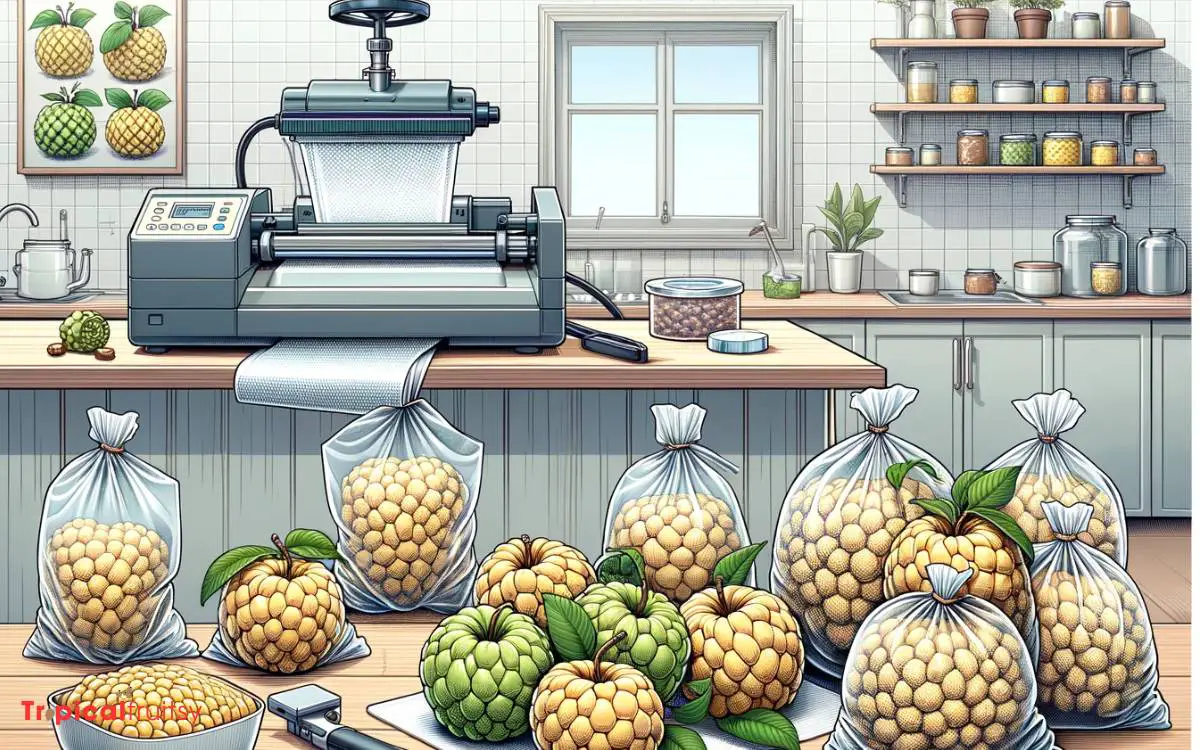
After dehydrating custard apples, vacuum sealing them further extends their shelf life by creating an airtight environment that prevents spoilage.
I ensure the dehydrated slices are cool before sealing to prevent condensation, which could lead to mold.
Using a vacuum sealer, I remove all the air from the plastic pouch, which effectively inhibits bacterial growth and oxidation processes that degrade the fruit.
I’m meticulous in checking the seal’s integrity, as any breach could let air in and compromise preservation. I also label each sealed package with the date, allowing me to track how long the fruit has been stored.
Storing these vacuum-sealed packets in a cool, dark place maximizes longevity, ensuring that the custard apples remain in an optimal state for consumption for months.
Can the Preservation Method for Custard Apples Also be Used for Freezing Them?
Yes, you can freeze custard apple easily using the preservation method. Simply peel and remove the seeds, then place the custard apple pulp in airtight containers or freezer bags. This method will keep the custard apples fresh and ready to use for an extended period of time.
Step 8: Canning and Preservation
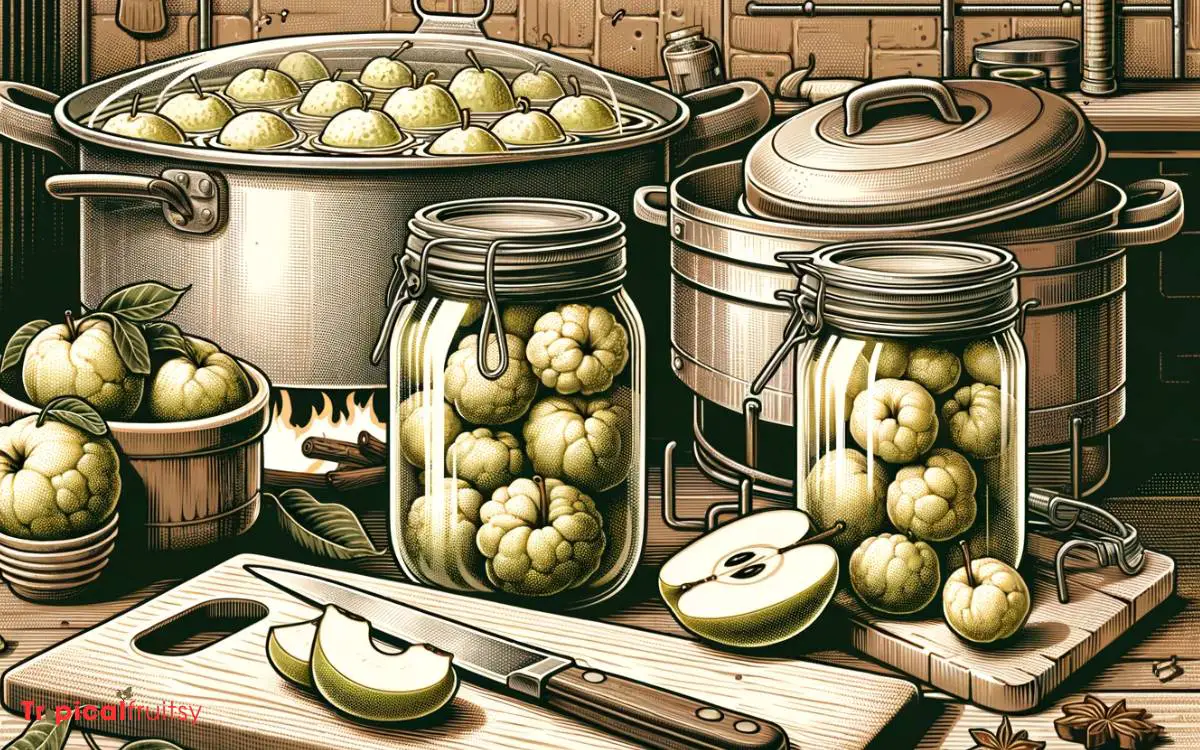
Turning to canning as another effective method, I preserve custard apples by sealing them in airtight containers, which allows them to maintain freshness for extended periods. This process involves meticulous steps to ensure the fruit’s longevity and quality.
Here’s a precise breakdown of the canning process for custard apples:
- Wash and Prepare: Thoroughly clean the fruit and cut into desired pieces.
- Blanch: Briefly boil the pieces to inactivate enzymes.
- Pack: Tightly pack the fruit into sterilized jars.
- Cover with Syrup: Fill jars with a sugar syrup to preserve flavor and texture.
- Seal and Process: Apply lids and process in a water bath canner to eliminate bacteria.
Each step is critical to prevent spoilage and retain the custard apple’s nutritional value.
Can We Keep Custard Apple in Fridge
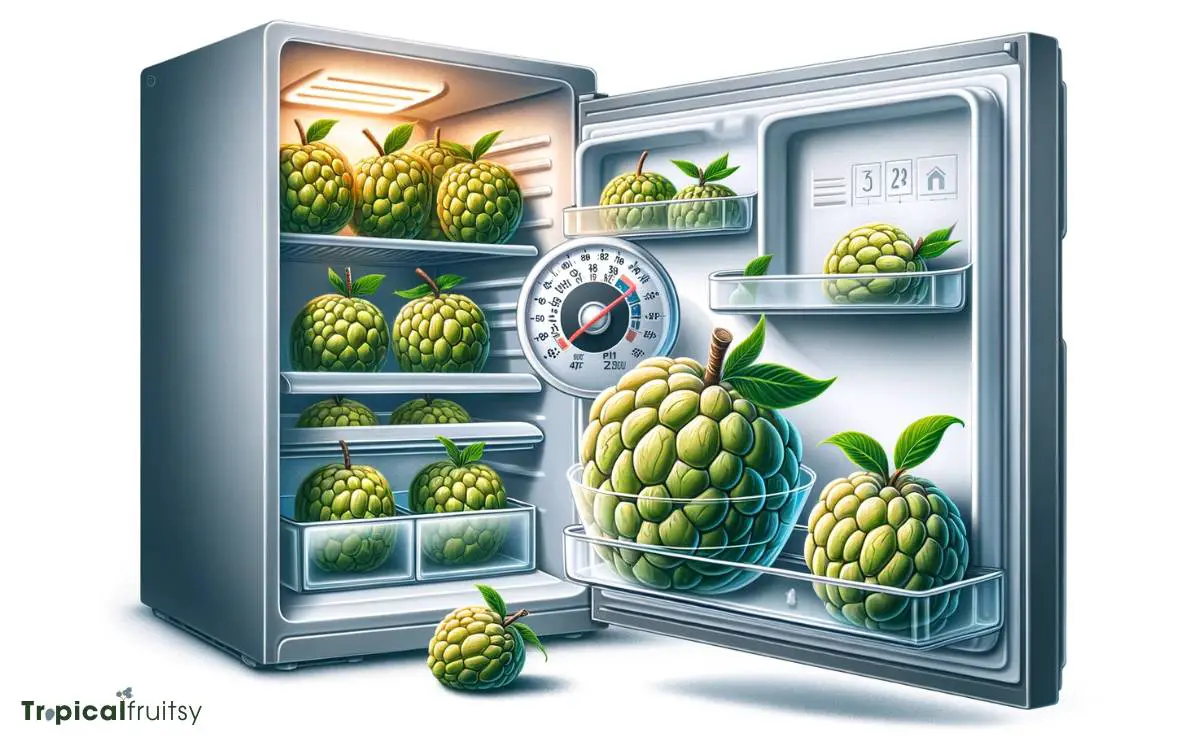
Yes, you can keep custard apples in the refrigerator to extend their shelf life. Refrigeration can help slow down the ripening process and keep custard apples fresh for a longer period.
Here are some steps to properly store custard apples in the fridge:
- Choose Ripe but Not Overripe Custard Apples: Select custard apples that are ripe but not overly soft or mushy. Overripe custard apples may not last as long even in the refrigerator.
- Store in a Plastic Bag or Container: Place the custard apples in a plastic bag or airtight container to help maintain their freshness and prevent them from releasing ethylene gas, which can speed up ripening.
- Keep Them in the Fruit Drawer: Store the custard apples in the fruit or vegetable crisper drawer of your refrigerator, which is designed to maintain optimal humidity and temperature for fruits and vegetables.
- Avoid Direct Contact with Other Fruits: Custard apples are sensitive to ethylene gas produced by some fruits like apples, bananas, and avocados, which can accelerate ripening. Store them away from such fruits to prevent premature ripening.
- Do Not Wash Before Refrigerating: It’s best to store custard apples unwashed. Wash them just before consuming to prevent moisture from causing them to spoil quickly.
When stored properly in the refrigerator, custard apples can last for up to a week or more, depending on their initial ripeness.
However, it’s essential to check them periodically for any signs of overripeness or spoilage and consume them promptly to enjoy their delicious flavor and texture.
Conclusion
In my quest to savor the creamy delight of custard apples year-round, I’ve discovered preservation is an art as much as a science.
Adopting these methods is like placing a time capsule in your kitchen; every thawed or unsealed fruit is a burst of past summer’s sweetness.
By meticulously selecting, washing, and employing techniques like freezing or canning, I ensure these tropical treasures aren’t just fleeting pleasures but enduring delicacies to relish anytime.





